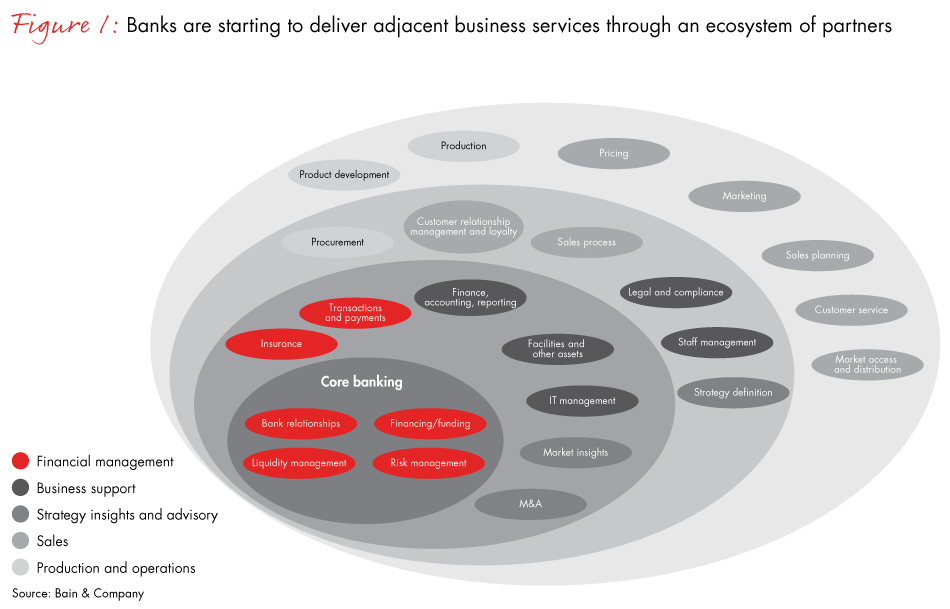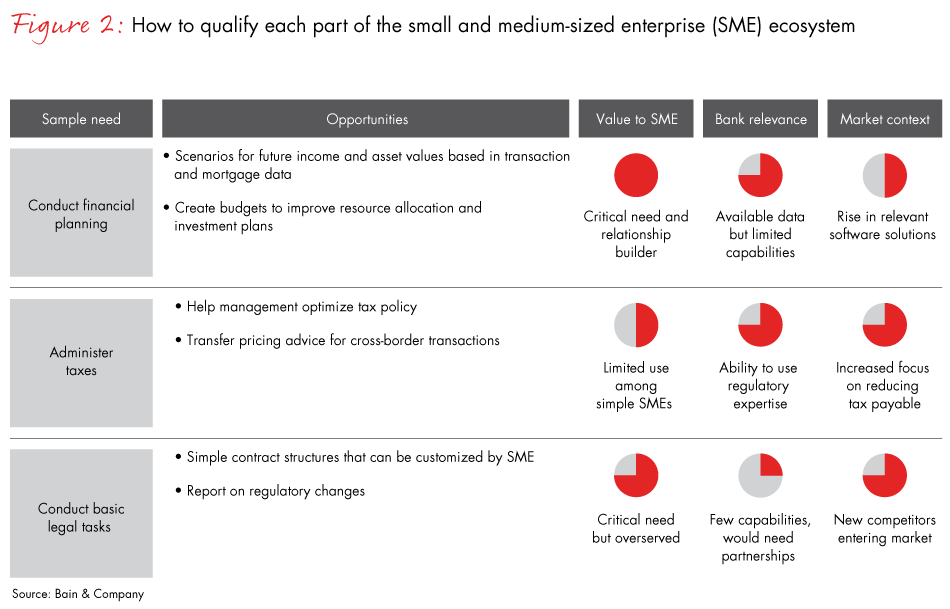Brief

At a Glance
- Small businesses that contend with the complexity of different systems for payments, accounting, human resources and bank transactions would value a simple, one-stop shop through an integrated system.
- Banks that devise or tap into an easy-to-use ecosystem of services could deepen their customer relationships and gain access to more data, which they can use to refine their offerings and make operations more efficient.
- Success hinges on gaining credibility for nonbank services and raising the level of service design.
- Three emerging approaches to a service ecosystem show promise; each builds on existing platforms and adds partners in adjacent services to focus on a narrow set of industries or stages in the small business life cycle.
It’s not easy for small companies to grind through the basic operations of running a business. Owners and managers spend substantial time navigating separate platforms for banking, enterprise resource planning, human resources and other activities, each with its own spreadsheets of critical information. Retail merchants must sell through multiple channels, including the online platforms offered by the Rakutens, Alibabas and Amazons of the world. And small and medium-sized enterprises (SMEs) selling online are heavy users of payments technology.
How can bankers help contain this sprawl? They can devise a simple, easy-to-use package that would integrate banking functions with, say, an external partner’s accounting and payroll software. Integrated technology packages could hold great appeal for SMEs, allowing banks to pursue new business models that would strengthen and expand their role with smaller business customers.
SMEs also look for advice and support at transitional moments such as making acquisitions or starting to export. By offering value-added services that address SMEs’ broader needs, banks can position themselves at the center of an ecosystem of interconnected services. Potential services include sales planning, pricing, procurement, accounting and reporting, payroll, staff management, payments, and liquidity management (see Figure 1).
The ecosystem model has already taken hold in other sectors, including mobile telecommunications, industrial goods (as exemplified by GE’s Predix platform) and insurance. Forward-looking insurers, for instance, are positioning themselves at the center of an ecosystem for services such as smoke, intrusion and leakage monitors for the home; telematics sensors for vehicles to reward safe driving or trigger maintenance alerts; health diagnostics and advice; and financial planning.

Some banks have made a promising start in developing their SME ecosystems. For example, ANZ in New Zealand targets start-ups, using monthly subscription fees for its revenue model. It partners with Honcho for business setup and other companies such as Xero for accounting. DBS is working with Singtel, the largest telecommunications provider in Singapore, to help SMEs go cashless and build e-commerce businesses. JPMorgan Chase recently acquired payment company WePay, in part, to build a wider suite of business services that already integrate with WePay so that business customers can link their banking accounts to these services and use them more efficiently.
Deeper relationship, deeper data
By developing an ecosystem of services beyond core banking or integrating into an existing ecosystem, banks should be able to tap new profit pools that they currently do not serve. A broader integrated offering should protect and deepen a bank’s customer relationship in the face of emerging new competition. Banks will also gain experience from new partnerships or go-to-market models that could help them speed up time to market and require less up-front investment.
Further, Bain’s analysis of ecosystems offered through platforms in several industries shows that there are positive knock-on effects. In banking, institutions will gain access to the SME customer interface and data, which they can use to refine their offerings and make operations more efficient. For instance, a bank offering proprietary payment terminals to retailers sees transaction flows and seasonal peaks and troughs, which would allow the bank to anticipate the working capital needs of its retailer clients.
In the mix of digital tools and human advice that a bank provides, service models will have to distinguish between the smallest clients and midsize firms. For the smallest clients, economics dictate a heavier use of self-service digital tools, including payments software development kits, which help companies incorporate financial features, such as payments, into websites and apps. Banks might even consider pioneering robo advice for very small firms. The major concern raised by micro firms, in our experience, is the complexity of moving among systems for payments management, accounting, human resources and bank transactions. This suggests substantial unmet demand for a simple, one-stop shop through a truly integrated system—not unlike the integrated platform for business banking needs that the banking community has discussed for years.
As client firms grow larger, their needs and challenges involve specific business issues, such as how to export effectively or how to hedge a risk. That’s where an ecosystem of specialists can add value. Advice and interactions with skilled staff will be critical to serving these larger firms effectively, earning their loyalty and expanding the share of their wallet.
Developing an ecosystem strategy starts with analyzing primary customer research to gain a comprehensive understanding of SMEs’ needs day to day and at each stage of their life cycle. A bank can assess each customer need on several dimensions.
- Is the need currently covered by an existing offering?
- How critical is the need for the customer’s business?
- How complex is the need, and how much special knowledge or time is required to serve it?
Bain Partner Seow-Chien Chew shares how banks can provide value-added services to small business ecosystems that will be mutually beneficial.
Keep it credible
One particular challenge for nearly all banks: Credibility is essential in this business, yet banks generally have low credibility for nonbank services. And SMEs complain even about core bank services such as slow, costly payments—especially international payments. Improving performance in this area and convincing SMEs of the improvement will be essential because payments acceptance and cross-border transactions have become basic needs for modern SMEs.
Banks also must raise their level of service design in creating an ecosystem. Offering a web page with disjointed click-through links to external partners will not satisfy SME customers who have made it clear that they want an integrated platform.
To be sure, an ecosystem strategy may not be right for all banks, such as those that aim to become low-cost, back-end utility providers of core services. But banks that have a deep understanding of customer needs, have strong customer relationships and deliver good customer experiences with their core services could confidently consider an ecosystem strategy. They can determine where to focus their ecosystem by considering each need in three dimensions (see Figure 2).
- Value added to the customer. How can the bank best meet target customers’ needs and thus become an important partner? The more critical and complex the needs, the more valuable an integrated solution will be.
- Relevance to serve. Which needs sit closest to the bank’s core capabilities? The bank will have more credibility if the need is closer to its core.
- Market context. Banks will want to assess the trajectory of overall market demand as well as the entry of new competitors or new solutions that could poach market share.
Three viable approaches
Once this key preparatory work has been done, banks can move swiftly to matters of design and operations (see Figure 3). While SME banking ecosystems are still in their early days, we have seen initial forays sort into three approaches.

One offers segment-focused value propositions, typically consisting of traditional bundles of services focused on a specific industry. In this approach, most of the solutions are provided in-house, they come with a free account and the business model counts on increased revenue from acquiring new customers. As an example, Deutsche Bank has an offering targeted to medical professionals. Features include a free bank account, information on relevant practices and financial topics, market research and competitor analysis, a profitability benchmarking tool for the customer’s region and specialty, and advisory services on business management.
The second approach consists of life-event ecosystems that capture broad needs during a life cycle event such as starting a business or international expansion. Key events turn into inflection points for banking relationships as they represent signifi cant profit pools and often prompt SMEs to consider switching banks. In this approach, banks can become an active partner in solving business problems, usually with the help of external partners. For example, Santander aims to attract SME clients with exposure to international markets and financial operations by offering nonfinancial services. Santander Trade includes trade services, import financing, leasing, a network hub, an expert business call line and other resources aimed at companies in the early stages of international expansion.
The third approach offers a complete solution to a recurring pain point. Many models in this category use some form of a payments ecosystem. Commonwealth Bank of Australia, for instance, focuses on merchant payments through point-of-sale terminals with back-end integration. This solution also mines transaction history to improve cash flow management. In another flavor of the approach, BBVA Compass Bancshares uses data analytics to enhance the sales of SME customers. It has an online tool that provides useful statistics and information, such as details about the SME’s customers, the level of customer loyalty, share of wallet, market research and competitor analysis.
While each model is different, those showing early signs of success do share certain traits.
- They build on strong existing platforms rather than standalone applications or products. A bank that has built a strong trade platform, for instance, should use that as a basis for its ecosystem before venturing into different realms.
- They design platforms for flexibility so that SME customers can combine the banking and business tools offered with their own proprietary technology and tools.
- They choose a focused theme, such as a narrow set of industries or a life event, and avoid broad catch-all solutions.
- They design the ecosystem around core banking needs, where they have higher credibility, rather than striving to appear new and different.
- They use partnerships to minimize complexity when entering adjacent services. Developing a point-of-sale terminal, for instance, is not a trivial endeavor and is better handled by a partner.
Embracing uncertainty
As banks seek to operationalize these ecosystems, they will need to navigate uncharted territory and deal with new situations. A partner might not deliver as promised, which could affect the bank’s credibility as the organizer of the ecosystem. A bank will need to decide whether to seek exclusive partnerships with a partner in each vertical or to have more of an open or managed architecture that allows multiple competing partners. Decisions around governance over and management of the partnership will also need to be addressed by banks.
The new ancillary services will be complex to manage, raising a number of questions. How deeply will relationship managers need to understand and be able to discuss offerings such as accounting software with their clients? Who will handle calls from customers on ancillary services, the bank or its partner?
The revenue and profit model will need to be designed. How should a bank monetize additional services—through a referral fee from the partners, a commission, revenue sharing, or by offering free or discounted services in return for better retention and richer customer data? Profits from new services, such as reselling a human resources module or an M&A referral to a specialist partner, might be smaller than core services. But the real value may lie in strengthening the customer relationship, which leads to sales of more banking products—for instance, the loans behind an M&A transaction.
Another key uncertainty concerns ownership or control of strategic assets such as customer data. A bank will have to negotiate how much and what type of data to share with partners as well as who has direct access to customers.
All of these issues will require time and effort from the senior corporate banking team. Banks will need to assess and possibly adjust their operating models as they proceed. Governance, structure, accountabilities and ways of working all might have to evolve. That’s what it will take to build a thriving ecosystem through which corporate banking units can strengthen their SME relationships and, over the long run, improve their economics. SME ecosystems around the world are evolving quickly, and banks considering moves into this realm will benefit by learning from the pioneers.
Martin Tornes, Niels Peder Nielsen, Joe Fielding and Seow-Chien Chew are partners with Bain & Company’s Financial Services practice. They are based, respectively, in Copenhagen, Copenhagen, New York and Singapore.

